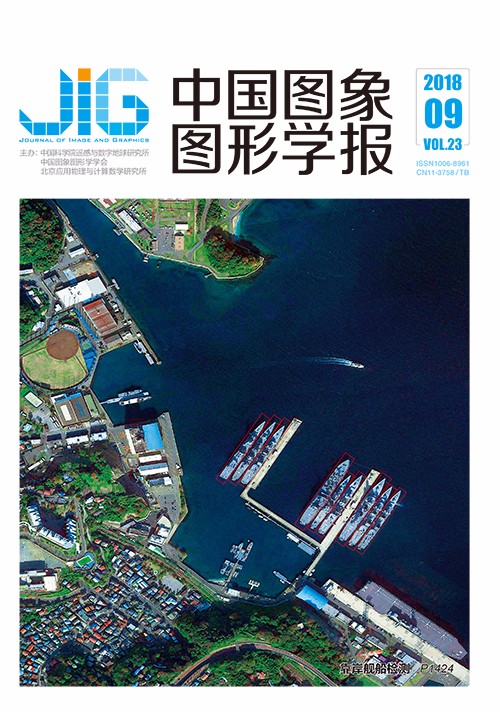
核稀疏表示和原子相关度的图像重建
摘 要
目的 针对目前基于稀疏表示的超分辨率重建算法中对字典原子的选取效率低、图像重建效果欠佳的问题,本文提出了核方法与一种高效的字典原子相关度筛选方法相融合的图像超分辨重建算法,充分利用字典原子与图像的相关度,选用对重建的贡献最大的原子来提高重建的效率和效果。方法 首先,通过预处理高分辨率图像得到高、低分辨率图像样本集,再用字典学习得到高、低分辨率字典对;然后,对字典原子进行非相关处理提高字典原子的表达能力;此后,再利用低分辨率字典,引入核方法和字典原子筛选方法进行稀疏表示,设置阈值筛选高相关原子,低相关度原子对重建贡献度低,在迭代过程中耗费计算量,所以舍去低相关原子,再对普通原子进行正则化处理后加入支撑集,处理后的字典原子对于重建具有很好的表达能力;最后,利用处理后的字典原子对低分辨率图求解稀疏表示问题得到稀疏表示系数,结合高分辨率字典重建出高分辨率图像。结果 实验通过与其他学习算法对比,得到结构相似度(SSIM)、峰值信噪比(PSNR)以及重建时间的结果。实验结果表明:本文方法与对比方法相比,图像重建时间提高了22.2%;图像结构相似度提高了9.06%;峰值信噪比提高了2.30 dB。原有的基于字典学习的方法对于字典选取具有一定的盲目性,所选取的原子与重建图像相关度较低,使重建效果差,本文方法获得的字典原子可以减少稀疏表示过程的时耗,同时提高稀疏表示的精度。引入核方法,改善经典算法中对原子选取的低精度问题,经实验证明,本方法能有效提高重建算法性能。结论 实验结果表明,图像的稀疏表示过程的重建时间明显减少,重建效果也有一定的提高,并且在训练样本较少的情况下同样有良好的重建效率和效果,适合在实际中使用。
关键词
Super resolution reconstruction algorithm based on kernel sparse representation and atomic correlation
Cheng Deqiang, Liu Weilong, Shao Lirong, Chen Liangliang(School of Information and Control Engineering, China University of Mining and Technology, Xuzhou 221008, China) Abstract
Objective To overcome the low efficiency of dictionary atom screening and the poor effect of image reconstruction results in some super-resolution methods based on sparse representation, which are mostly unconsidered in atom screening, this paper proposes a super-resolution reconstruction algorithm. This algorithm is based on a combination of kernel method and dictionary atomic correlation, which fully uses the correlation between the dictionary and image, and selects the atoms, which significantly contributes to the reconstruction results and improves the efficiency and effect of the reconstruction. Method First, a set of low-and high-resolution samples are obtained by pre-processing applied on the high-resolution images. Low-and high-resolution dictionaries are learned by using a dictionary learning algorithm. Second, the dictionary atom is uncorrelated to improve the ability of the dictionary atom to express. Third, by using the low-resolution dictionary, the kernel method and dictionary atom screening method are used for sparse representation, to set thresholds to screen for highly correlated atoms, eliminate low-correlation atoms, and then use the normal atoms for normalized processing. The resulting high-and low-resolution dictionary atoms are incoherent, thereby eliminating the similarity between dictionary atoms, enhancing the expressive power of dictionary atoms, and helping to select the next dictionary atoms. In the process of solving the representation coefficient, selecting the appropriate atoms from the low-resolution dictionary to the support set, which is the largest part of the computation, is necessary. When updating the support set, the dictionary of low-resolution images is trained from other images, which leads to the large contribution of some atoms to the samples. The atoms with low correlation often do not contribute during the iteration process, but each iteration has considerable computation costs. At the same time, for the image blocks that need to be restored, a number of highly correlated atomic pairs have a major contribution to reconstruction. To reduce the computational complexity and improve the reconstruction effect, this paper improves the traditional method by using the correlation of the residual and atom to conduct efficient dictionary selection. Finally, the sparse representation problem is solved to obtain sparse coefficients, and the super-resolution image is recovered by using these coefficients. High-resolution image blocks are obtained by using high-resolution dictionary and coefficient representation coefficients, and then, high-resolution images are synthesized by utilizing image blocks. Result The performance of algorithm reconstruction is measured by PSNR, structural similarity, and time and compared with Yang, MSDSC, and SDCKR algorithms. In the experiment, the following test chart is analyzed in detail, and the ImageNet standard image database is trained to obtain additional detailed experimental results. The experimental results show that, compared with the contrast method, the image reconstruction time is increased by 22.2%, the image structure similarity is increased by 9.06%, and the PSNR is increased by 2.30 dB. The original method based on dictionary learning for dictionary selection has a certain blindness. The atom and reconstruction image correlation degree is low, and the reconstruction effect is poor. This method can reduce the dictionary sparse representation of time consumption and improve the accuracy of sparse representation. In the super-resolution reconstruction of the classical image reconstruction algorithm, the effect is not ideal and the reconstruction time is too long. The main reason is that the dictionary selection efficiency is low, aiming at the abovementioned problem. For the improvement of dictionary learning algorithm in solving the sparse coefficient method in the process of nuclear innovation and the introduction of machine learning and new atom selection method, this paper presents a test with the commissioning of a large number of practical engineering images. The experimental results show that this method can improve the reconstruction effect and reduce the time required for reconstruction. Conclusion Compared with the same algorithm of dictionary learning, the reconstruction time of this algorithm is also less. Experiments have proven that in this method, the reconstruction time of image sparse representation process is significantly reduced. The reconstruction effect is also improved, with good reconstruction efficiency and effectiveness under the condition of few training samples, which is suitable for practical use.
Keywords
sparse representation super-resolution reconstruction kernel method atomic correlation unrelated processing
|



 中国图象图形学报 │ 京ICP备05080539号-4 │ 本系统由
中国图象图形学报 │ 京ICP备05080539号-4 │ 本系统由